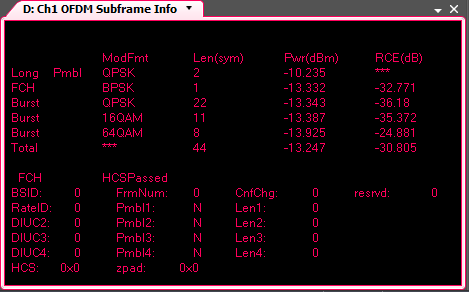From FCH - Data Subcarrier Modulation Format (802.16 OFDM)
: See 802.16 OFDM Standard Setups/Presets Table.
The VSA uses information within the frame control header (FCH) to determine the Data Subcarrier Modulation Format. If the FCH symbol is not present, the data subcarrier modulation format is automatically detected instead. The FCH information is used only for the first data burst, for subsequent bursts the data subcarrier modulation format is automatically detected.
For more information, see Data Subcarrier Modulation.
About FCH "Frame Control Header"
A frame control header (FCH) is only associated with demodulating downlink data bursts, not with uplink data bursts.
A downlink PHY Physical Layer protocol data unit (PDU (protocol data unit) The data unit exchanged between peer entities of the same protocol layer. On the downward direction, it is the data unit generated for the next lower layer. On the upward direction, it is the data unit received from the previous lower layer.) starts with a long preamble, which is used for PHY synchronization. The preamble is followed by a frame control header (FCH) burst. The FCH has the BPSK Binary phase shift keying - A type of phase modulation using 2 distinct carrier phases to signal ones and zeros. modulation format. The FCH is followed by one or more downlink data bursts, each transmitted with different burst profile. Data bursts with more robust modulation types are transmitted before bursts with less robust modulation (e.g. a QPSK Quadrature phase shift keying burst is transmitted before a 64QAM burst).
The following example of the Subframe Info data trace shows the FCH (BPSK), followed by data bursts of QPSK, 16QAM and 64QAM.

The FCH may be followed by broadcast messages such as a downlink map (DL-MAP downlink map: A MAC message that defines burst start time for both time division multiplex and time division multiple access (TDMA) by a subscriber station (SS) on the downlink.) message and/or uplink map (UL Up Link (reverse link: from cell phone to base station)-MAP) message, then uplink channel descriptor (UCD uplink channel descriptor: A medium access control message that describes the PHY characteristics of an uplink.) and downlink channel descriptor (DCD downlink channel descriptor: A MAC message that describes the PHY characterstics of a downlink channel.) messages.
See Also
